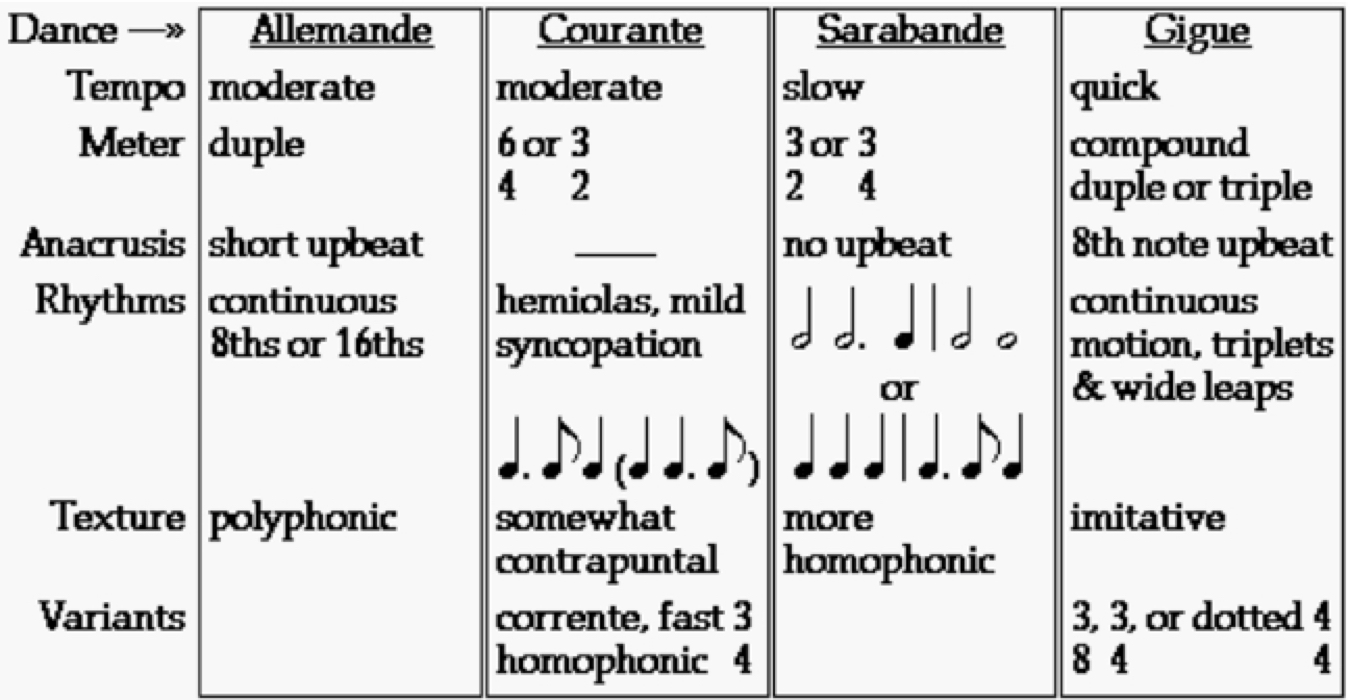—This chart describes the features of the four dances that serve as the core of a standard Baroque suite.

| The following tables provide useful information about the sonata da camera, the sonata da chiesa, and the style features that can help you distinguish movements, dance types, and sonata types. |
|
|
||
|
|
|
|
Return to Encounter 6 Listening
|
Standard Baroque Dances
—This chart describes the features of the four dances that serve as the core of a standard Baroque suite. |

|
Return
to Encounter 6 Listening
Return to top
|
Sonata da chiesa (Church sonata)
—evolved from the sectional canzona —some movements subdivide into canzona-like contrasting sections (see 1st movement of Op. 5, No. 1) —usually alternates fast and slow movements (Slow-Fast-Slow-Fast) —most solo church sonatas add a fifth movement, usually somewhere in the middle —continuo may use violone, archlute, and/or organ —binary (dance) form is usually not used (except in some concluding gigues) |
|
|
I—severe, majestic, solemn, or proud
—a stylized processional |
—often a slow allemande (andante = walking tempo, sometimes with
walking bass!)
—occasionally a French overture, often marked grave (see 1st movement of Op. 3, No. 10) |
| II—resolute or contented |
—usually a bright, fast fugue
—duple meter —continuo participates in imitation |
| III—tenderly melancholic |
—often a slow triple meter operatic aria
—often uses sarabande rhythms |
| IV—light and carefree |
—often a fast gigue or allemande (usually not labeled as such), occasionally
a gavotte or balletto
—imitative texture —the only church sonata movement where binary (dance) form might be used |
Return
to Encounter 6 Listening
Return to top
|
Sonata da camera (Chamber sonata)
—alternates fast and slow movements (Slow-Fast-Slow-Fast) —movement order less predictable than sonata da chiesa —continuo may use violone, archlute, and/or harpsichord —most movements use binary (dance) form |
|
| I—Preludio, slow tempo |
—often a slow allemande
—similar in mood and character to the 1st movement of a sonata da chiesa |
| II—Fast tempo | —often an allemande or corrente (fast Italian version of a French courante) |
| III—Slow tempo |
—sarabande or other slow dance
—slow allemande used in Op. 2, No. 4 (DWMA) |
| IV—Fast tempo |
—often a gigue, gavotte, or allemande
—more homophonic than the last movement of a sonata da chiesa |
Return
to Encounter 6 Listening
Return to top
|
|
||||
|
Tempo?
fast or slow? |
Meter?
duple, triple, or compound? |
Anacrusis?
short, long, or no upbeat? |
Instrumentation?
1 or 2 violins with continuo? |
Continuo?
organ or harpsichord? |
|
|
||||
|
Which movement? |
||||
| I | slow, duple meter | |||
| II | fast, duple meter | |||
| III | slow, triple meter | |||
| IV | fast, compound meter |
Type of movement? |
||
| French overture | slow, duple meter with dotted rhythms, sometimes with a short upbeat figure | |||
| Allemande | fast or slow, duple meter, often with a short upbeat figure and somewhat polyphonic with continuous 8th or 16th note motion | |||
| Fugal movement | fast, duple meter, with or without upbeat | |||
| Sarabande | slow, triple meter, without upbeat, often with agogic accent on beat 2 | |||
| Gigue | fast, compound meter, often with an 8th note upbeat |
Type of sonata? |
||
| Solo sonata | 1 violin with continuo | |||
| Trio sonata | 2 violins with continuo | |||
| Sonata da chiesa | organ continuo and frequent use of imitative texture, especially in fast movements | |||
| Sonata da camera | harpsichord continuo and frequent use of binary (dance) form | |||
Return
to Encounter 6 Listening
Return to top
Created 11/01/05 by Mark Harbold—last updated 9/16/20